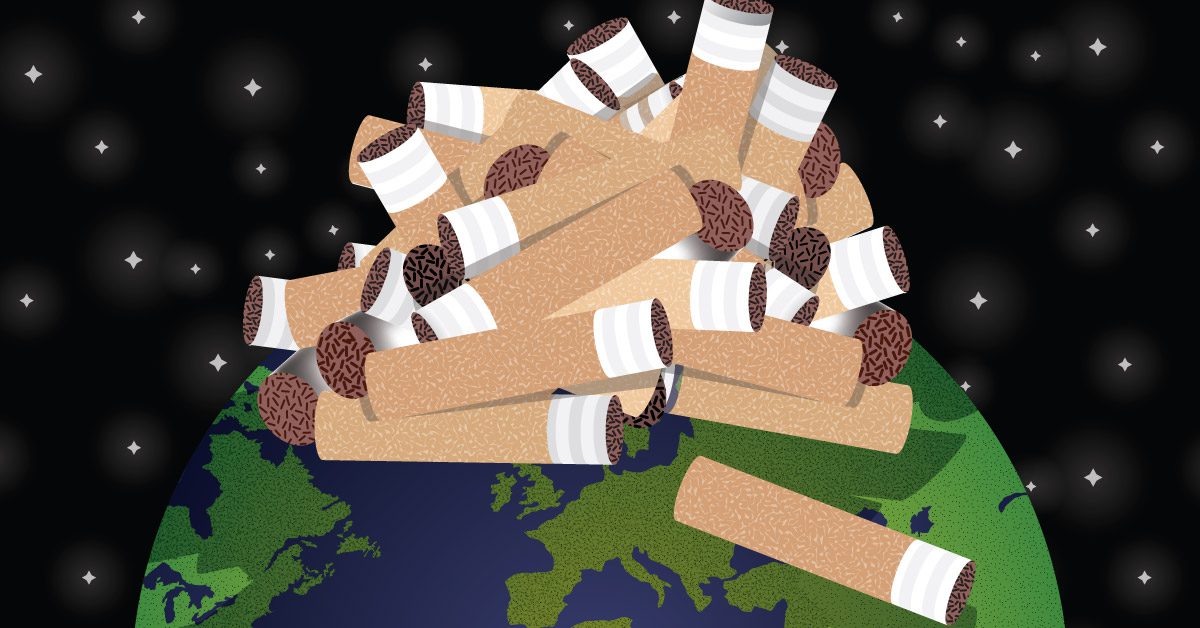The Environmental Impact of Tobacco
 We all know that smoking and vaping pose a huge threat to our physical health — but the detrimental effects go beyond bodily harm. From polluting the air we breathe to cluttering our streets and beaches with litter, the environmental impacts of tobacco are expansive, and often overlooked.
We all know that smoking and vaping pose a huge threat to our physical health — but the detrimental effects go beyond bodily harm. From polluting the air we breathe to cluttering our streets and beaches with litter, the environmental impacts of tobacco are expansive, and often overlooked.
Litter
Cigarette butts and e-cigarettes are the MOST littered item in the United States. Over 750,000 metric tons of cigarette butts make their way into the environment every year. Americans also generate nearly 3 million tons of consumer electronic waste, including e-cigarette waste, that ultimately end up in landfills.
Quick Facts
- Cigarette butts are the most predominantly littered item on U.S. roadways, retail areas, storm drains, loading docks, construction sites and recreational areas.
- Under optimal conditions, it can take at least nine months for a cigarette butt to degrade, and e-cigarettes are NOT biodegradable.
Deforestation
Every year, the tobacco industry is responsible for a massive amount of deforestation across the world, contributing to the vicious cycle of climate change. The tobacco plant is very sensitive and can only grow in very specific conditions that completely drain the soil of nutrients, preventing other plants from growing and thriving even after it’s been harvested.
Over 5.3 million acres of fertile land are being used to grow tobacco — most of which had to be cleared of trees. As the soil loses nutrients, more fertile land is needed for manufacturing — meaning thousands are cut down each year.
Quick Facts
- The tobacco industry chops down approximately 600 million trees every year. On average, each tree produces enough paper for 15 packs of cigarettes.
- Tobacco production uses up more water and wood and requires more pesticides applied to it than most other crops — affecting the water supply and further contaminating soil.
Air Pollution
Secondhand smoke contains over 4,000 compounds, most of which are toxic and carcinogenic. On top of the negative health effects of secondhand smoke, it’s also rapidly depleting our ozone layer. When you consider the deforestation the tobacco industry already causes, it is one of the most harmful industries regarding air pollution.
Quick Facts
- Tobacco farmers typically clear land by burning, releasing several thousand pounds of toxic chemicals into the air. Burning increases the amount of CO2 in the air, damaging the ozone layer.
- The tobacco industry has a similar environmental impact to 16 million cars.
Wildlife
Just like humans, our wildlife also suffers greatly from smoking and tobacco waste. Secondhand smoke harms the small lungs of an animal at a much faster rate, and the litter from cigarettes does not digest when eaten. Forest-dwelling animals are also affected by deforestation — and as more and more animals lose their habitat, more and more species are wiped of the map.
Quick Facts
- The most commonly affected animals are beach dwellers — turtles, crabs, seals, etc. — since they ingest more cigarette butts than others, then subsequently feed their young.
- Scientists have also found cigarette butts in the stomachs of domesticated animals, such as cats, dogs and birds.
Smoking will always affect more than just the person doing it. It’s time to step up and take a stand — not just for our health, but for the health of our planet. For more information on policy changes that can make a positive impact, visit our Get Involved page.







